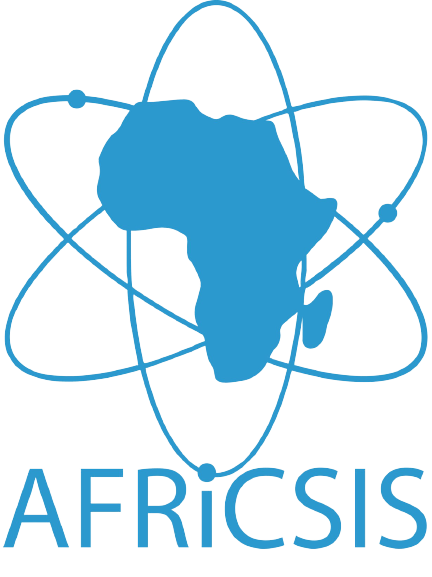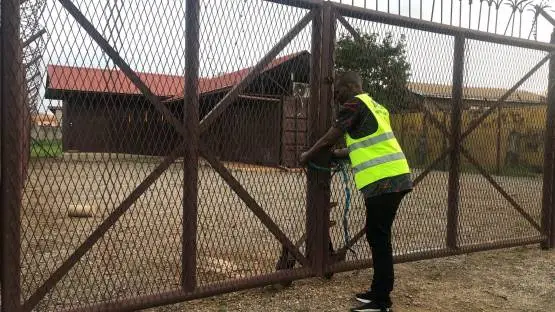Cameroon’s first ever storage facility for low-activity disused sources was built in 2019. The storage facility provides enhanced safe and secure storage, including physical protection with multiple fences, alarm systems, and locks, as well as a surveillance camera system. (Photo: M. Gaspar/IAEA)
YAOUNDE, CAMEROON – Nuclear security is a serious matter in all countries – even more so in a region with turbulence and occasional violence, such as Central Africa. This is why the government of Cameroon has over the last few years increased nuclear security, with support from the IAEA and its partners.
While Cameroon does not have any nuclear facilities such as a power plant or a research reactor, it uses nuclear technology in medicine, industry, and research. There are some 200 radioactive sources in use along with 50 disused sources – those not potent enough to be useful anymore, but still containing enough radioactive material to cause harm. Managing these radioactive sources and keeping them under regulatory control, away from the hands of those with malintent, has been a major focus of the country’s National Agency for Radiation Protection (NRPA), the regulatory body in charge of both radiation safety and nuclear security.
Until 2019, disused radioactive sources were mostly kept in the backyards or makeshift storage facilities at the institutions that had used them. A Nuclear Security Support Plan, developed in cooperation with IAEA experts, has formed the basis of the country’s activities since, starting with the development of an inventory of all radioactive sources.
With the financial support of the United States National Nuclear Security Administration and the technical support of the IAEA, NRPA has built a secure storage facility for low-activity sources – those typically used in industry, in old smoke detectors, and also in brachytherapy, a form of radiotherapy based on implanting small radioactive sources inside the body. The storage facility, inaugurated in 2019, provides enhanced safe and secure storage, including physical protection with multiple fences, alarm systems, and locks, as well as a surveillance camera system. At the end of their useful life, high activity sources, such as those used in external radiotherapy, are repatriated to their country of origin or another country with adequate capabilities for reuse, recycling, storage, or disposal. Sources still in Cameroon are planned to be removed under an international IAEA project funded by Canada through the IAEA Nuclear Security Fund.
The storage facility in Cameroon contains several disused sources, with more to be delivered in the coming months. As a next step, these sources will need to go through what is called conditioning: they will be removed from the devices that contained them, characterized, and placed in safe and secure storage capsules and containers. This procedure lowers the potential harm the disused sources can cause if they come into contact with people. Experts sent by the IAEA will supervise the conditioning of the sources later this year, said Jean Felix Beyala Ateba, the senior research officer in charge of the management of disused radioactive sources at the NRPA. “Local expertise exists to carry out conditioning, but we have requested an international expert to supervise the process the first time around,” he said.
Security is also a key consideration during the transport of the sources from the airport to the user’s facilities, or the transport of disused radioactive sources – whether from a research facility or hospital to the secure storage site or to the port for repatriation to their country of origin. In order to strengthen the regulator’s skills in this area, an exercise is planned for later this year, involving several neighboring countries, too. “When the sources are in transport between two locations, the vulnerability for theft or sabotage is higher, and radiation protection officials work in tandem with law enforcement authorities to secure the transport,” said Beyala Ateba.
At the same time, the IAEA is providing assistance to Cameroon in the development of the country’s transport security regulations.
Overall, about 49% of all thefts reported to the IAEA since 1993 have occurred during the authorized transport of nuclear or radioactive material, such as sources. “This figure has grown to almost 60% in the last decade, which highlights the importance of strengthening transport security measures worldwide,” said David Ladsous, Head of Transport Security at the IAEA.

A worker from Cameroon’s nuclear regulator entered the country’s first-ever storage facility for low-activity disused sources. (Photo: M. Gapsar/IAEA)
Securing soccer
The NRPA and law enforcement organizations cooperated closely earlier this year during the Africa Cup of Nations, one of the world’s premier soccer events, which took place in six stadiums and five regions in Cameroon in January and February 2022.
NRPA’s focus was to prevent anyone from bringing radioactive material into the stadiums and other key locations and endangering people. NRPA staff surveyed the stadiums and other locations using radiation detection equipment, dosimeters in backpacks, and trained front-line police officers in the use of handheld radiation detectors. Everyone entering the venues would be checked for radiation, as part of the overall security screening process. On the few occasions when the detection equipment emitted an alarm, indicating the possible presence of radioactive material, the regulatory body’s experts were called onto the site to carry out an assessment. It turned out that the alarms registered were caused by potassium-40, a naturally occurring radioactive isotope present in certain rock formations and construction materials, such as tiles made from such stones. “While we found no criminal activity, NRPA believes that the implementation of nuclear security measures was a very important deterrent to those who may have wanted to cause harm,” Beyala Ateba said.
Following a request from the government, the IAEA helped local authorities develop a nuclear security plan for the games under the IAEA’s program to support major public events. The IAEA provided training and loaned equipment: 10 backpacks with radiation detection capabilities, 150 handheld detectors for front-line officers, and 10 devices to identify the nature of any radiation detected by the front-line officers’ handheld devices. The regulatory authority also received a backpack, an identifier, and nine handheld detectors as donations for future use.
What did Cameroon get out of this exercise? Augustin Simo, Director General of NRPA, said: “We have enhanced skills and equipment, which we continue to put to good use in our everyday work, keeping Cameroon protected against nuclear terrorism. And for Central Africa, we have a number of trained experts who can support the IAEA when delivering training on nuclear security.”
The security, as well as the safety of radioactive sources worldwide, will be the topic of an IAEA conference next week, which will discuss challenges, foster coordination, and share experience among national authorities. For more information, see the conference webpage.
This article was authored and first published by the International Atomic Energy Agency.

